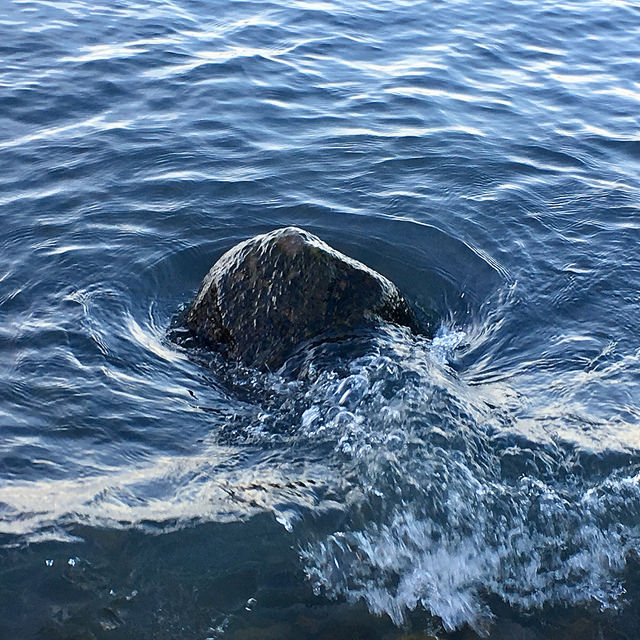
“When the mind has put off the old self and shall put on the one born of grace, then it will see its own state in the time of prayer resembling sapphire or the color of heaven; this state scripture calls the place of God that was seen by the elders on Mount Sinai.” ~ Evagrius of Pontus (4th c. monastic)
In terms of photography, I always encourage people to notice when certain subjects resonate, when you feel attunement. These are moments that are telling you to pay attention, that there’s a dynamic interaction happening. So too with books. I’m an avid reader and some books speak to me in ways that makes them perennial favourites. These are ones I go back to again and again. The book, The Blue Sapphire of the Mind: Notes for a Contemplative Ecology, by Douglas Christie is one of those for me.
In my last post, I talked about a new course I’m developing called Know Your Place and introduced the field of contemplative ecology. Christie’s book is one of the best I’ve read on the topic. He defines contemplative ecology as “identifying our deepest feeling for the natural world as part of a spiritual longing. It sets ecological understanding in the widest possible framework, not just how organisms interact with their environment but also how ecological networks are shaped by human culture and thought, including human emotion, reason, imagination, and soul.” ~ Douglas Christie
There are religious undertones to this book (it’s written with many references to early Christian contemplative traditions), but they don’t overwhelm the main premise – that knowing your place can contribute to ecological renewal. And, we need a whole lot of ecological renewal right now.
With contemplative photography we practice seeing with the heart; senses are open, we’re paying close attention, and we see how everything is connected. The same goes for contemplative ecology. With this approach to life we feel a sense of responsibility, not only to our human community, but to the entire ecological community. Christie poses many challenging questions throughout the book.
How can we learn to live differently so that we don’t continue to visit our most destructive impulses upon the natural world? Who are we in relation to the natural world, ultimately? How does our self-understanding influence our sense of what it is to live in and tend to the wild world?
Christie begins with these basic assumptions.
* Life is not made up of objects, but rather networks of dynamic interactions.
* Change is ongoing and necessary for life.
* Humans are dependent on the health of these networks.
With these assumptions in mind, Christie devotes each chapter to a different aspect of contemplative ecology. I’ll summarize them below, along with images and quotes from the book.
Chapter 1 – Contact

What is contact and what does it have to do with the blue sapphire of the mind? I love the visual of the mindset of contemplation resembling a blue sapphire, one of my favourite colours (and gems). Contact has to do with the state of mind we bring to our contact with the world. How aware are you of how you are touched by and how you touch the world?
Your journey in life is unfolding within a specific, geographic place. This place needs you as much as you need it. When you’re attentive to the world, you will see it as the mystery it is; you will approach it with openness, humility, and awe. The simple act of paying attention opens you to see what’s there.
Chapter 2 – Penthos (The Gift of Tears)
“We only grieve for what we know.” – Aldo Leopold, A Sand County Almanac
Aldo Leopold ponders the rarity of a once abundant prairie wildflower, the cut-leaf Silphium. He wonders what contributed to it’s disappearance and why people weren’t more upset about it. Why are we numb to the extinctions happening at a rampant pace? Well, maybe we don’t know enough about what’s happening or why it’s important. If we did, we’d feel grief. When we really know someone or something or a place, there will be grief and mourning, as well as joy and celebration. Christie asks, “How might openness to grief and mourning facilitate a more intricate and expansive knowledge of the whole and a greater awareness of the significance of our own relationship to the whole?” He emphasizes the importance of tears.
“Tears, considered as gift, can open the soul. This is particularly important in an age of ecological loss and destruction. Grief is not simply a private, personal response to loss but also comes to expression (or fails to) within a broader social, cultural, political and ecological fabric. Tears for lost possibilities or gratitude for what has been, for what might yet be retrieved and restored. Tears as a source of renewal. Tears that pierce the heart.”
We must express the losses, whether through tears or the arts, before any healing or renewal can take place.
Chapter 3 – Topos (At Home, Always a Stranger)
“All the days of your life, keep the frame of mind of the stranger.” – Abba Agathon
What does it mean to be a stranger at home? We talk about this in contemplative photography all the time. It’s seeing freshly, with beginner’s mind. Seeing the unfamiliar in the familiar, the extraordinary in the ordinary. Letting go of our preconceived notions, judgments, and opinions.
“Place making is beholding, inhabiting, and cherishing the particular places where we live. To enter into and be shaped by the stories and the culture of a place. It is a way of being in the world that allows us to cherish it with all the feeling we are capable of. To say the name of a place, to tell a story about a place is to waken memory, conjure up everything that ever happened there, and make it present to the community. It becomes woven into the identity of the people. It teaches lessons and imparts wisdom.”
So, part of feeling at home in a place is knowing intimately the stories of that place. We also must see how all of the places we’ve lived and called home have shaped our lives, even if some of them are lost to us now. Can we cherish these places and recognize their complexities?
Chapter 4 – Prosoche (The Art of Attention)
Attention is an act of love. Learning how to look, to see, to pay attention with eyes of love is one of the highest of callings. And, it takes practice. This way of seeing goes beyond the surface into the heart of reality.
What does it mean to see and apprehend the whole? It means that we begin in silemce and stillness; there we cultivate an open and receptive awareness. Only then will we see all things in relationship with one another. Christie asks, “What is the moral or spiritual character of the relationship you have with the place where you live? Does it involve reciprocity and responsibility?” There’s a difference between appreciating something for its physical beauty and becoming aware of how the way we live our lives affect it. Contemplative practice asks that we not only see the world, but that we see our place in it.
“The often hidden work of contemplative practice – rooted in a simple, open-hearted attention – does have enormous meaning and significance. The deepening of awareness that occurs through this practice changes the quality of being, not only one’s own but also the world’s. It can soften the hard edges of habitual perceptions so that what seemed distinct or separate now appears as intimately woven into the fabric of one’s very being. What shift or expansion in our very sense of contemplation would need to occur for us to include the living world as part of our practice? How could it lead to ecological renewal?”
Chapter 5 – Logos (The Song of the World)
Does the world have a voice? How do you listen to the world? And why does it seem so difficult to cultivate the habit of deep listening that is at the heart of contemplative practice? Christie asks provocative questions, doesn’t he? He asks us to listen, really listen, to the world and what it’s saying to you. This involves living in the space of silence, a sometimes uncomfortable and uncertain place to be. But, this is the only way you’ll know how to respond effectively.
Early Christian contemplative traditions saw Logos, the Word, as “the divine, creative principle through whom all of creation came into being.” They saw the divine as shining through all created things. However, there’s another kind of knowledge that, paradoxically is only found in unknowing and can only be experienced by listening to silence. I know this sounds abstract but it’s exactly what’s required to learn to truly see. We need to let go of our pre-conceptions, our judgments – our knowing, to see what’s really there. Christie cites Thoreau as a master of this. He spent time at Walden Pond hoeing beans, giving himself over to the present moment, paying attention, and becoming a see-er. Do you need solitude or a certain place for this kind of work? Not necessarily. Deepening awareness of our relational world can be practiced anywhere.
Chapter 6 – Eros (Exchange, Intimacy, Reciprocity)
“We live in a world charged with eros, where momentous encounters and exchanges are endlessly unfolding before us, among us, and within us.”
 Is it possible to recover a capacity for intimacy that can help us overcome this profound alienation and contribute to a more thoughtful, tender response to the living world? Eros, according to Christie, is the longing to share in the life of another, whether that “other” be a person, a place, a non-human species, or God. It’s expressed as desire or longing. Developing an intimate feeling for the world is critical to understanding and caring for it. To experience eros is to be vulnerable, to let go of control and allow yourself to be touched by life. Thoreau did just this, as he moved from transcendental idealism, where human consciousness was primary, to mindful naturalism, where the natural world became primary.
Is it possible to recover a capacity for intimacy that can help us overcome this profound alienation and contribute to a more thoughtful, tender response to the living world? Eros, according to Christie, is the longing to share in the life of another, whether that “other” be a person, a place, a non-human species, or God. It’s expressed as desire or longing. Developing an intimate feeling for the world is critical to understanding and caring for it. To experience eros is to be vulnerable, to let go of control and allow yourself to be touched by life. Thoreau did just this, as he moved from transcendental idealism, where human consciousness was primary, to mindful naturalism, where the natural world became primary.
At the root of contemplative practice is a willingness to open your senses to the sight, touch, voice, fragrance, and taste of the other. By doing so, you’ll experience the reciprocal exchange with the world that is the hallmark of any good relationship. This is how healing begins.
Chapter 7 – Kenosis (Empty, Emptied)
Another important contemplative practice is being able to face and learn from suffering, including the loss of meaning and hope. What does it mean to accept suffering? It’s not to accept the suffering itself but to accept the fact that it exists. Christie says that while this sounds fatalistic, it’s not. Instead, it’s a way of participating in or engaging with the suffering, in dealing with it directly. You remain empty, open, alert, and attentive to others, in particular to their suffering. And this includes the Earth. We need to be able to face the emptiness and darkness and stand in solidarity with others.
Chapter 8 – Telos (Practicing Paradise)
In the final chapter, Christie considers how the contemplative practice of experiencing paradise might help us address the growing fragmentation and degradation of the living world. He cites Thoreau as one who showed what it means to experience paradise right here, right now. He exemplified a life with less worry and less attachment to “things.” Thoreau lived with a mind like blue sapphire, open and responsive to the world. He experienced paradise as already here and discovered that we have what we seek.
“It is present to us always — in the mature dogwood blossoms against the dark evergreens in the cloudy garden. In the song of the unknown bird. In everything that exists. It is accessible to all of us. All we have to do to encounter it, to feel the heavenliness of things, is to open our eyes or ears. Live in each season as it passes; breathe the air, drink the drink, taste the fruit, and resign yourself to the influences of each.”
Christie goes on to say that we’re losing this sense of paradise through “the loss of biodiversity, the extinction of species, and the erosion of the ecological web through which life is maintained.” Yet, to turn this around we need to ask ourselves what we’re willing to do. Are we willing to to do only so much, as long as it doesn’t inconvenience us? The healing and renewal of paradise depends on how we answer that question. It depends on our ability to experience the beauty as well as the brokenness. To cultivate the blue sapphire of our mind.
What struck you most about these aspects of contemplative ecology?
** Books mentioned have Amazon affiliate links, meaning I make a few cents if you purchase through my link. I only recommend books that I’ve read.